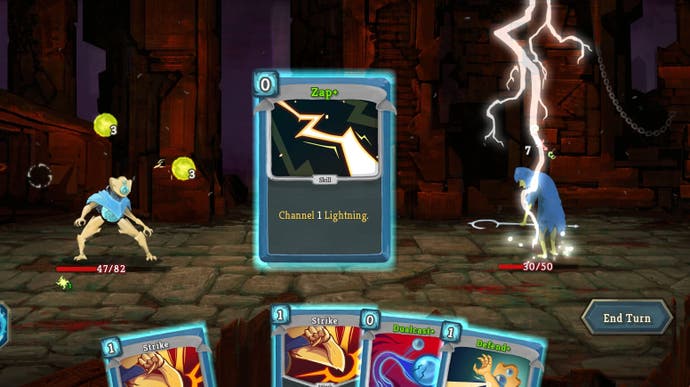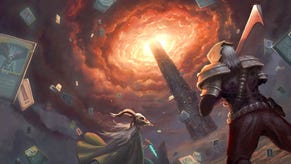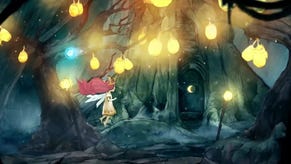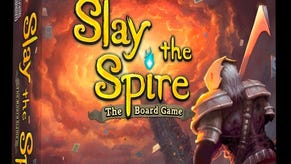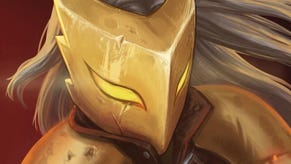Slay the Spire review - a gorgeous blend of dungeon-crawler and card-battler
Finial fantasy.
In the middle of the journey of our life, I found myself faced with a choice: eat the banana or eat the donut? The more I thought about it, the more I realised that this choice was trickier than it initially seemed. The banana would heal me for seven per cent of my health. The donut would raise my HP cap by seven. To be healthier now, or to potentially be healthier than ever in the future?
In the end, I'm an optimist, so I went with the donut. I definitely thought about it, though. I thought about it for a good five minutes. It's probably the longest, all told, that I have ever been confronted with a donut before making my mind up about it.
Slay the Spire isn't just a devious blend of card-battler and roguelike, then. It's also a game that likes to tempt you with donuts. It likes to bother you with ghosts and gods and tricksters and traps. You start at the lowest level of a tower and each floor contains a battle or a treasure or a shop or a campfire (this last one can either heal you or be used to improve one of your cards). But like FTL, whose forking-path structure it loosely follows, Slay the Spire will occasionally chuck in a random event. Banana or donut, for example. What will it be?
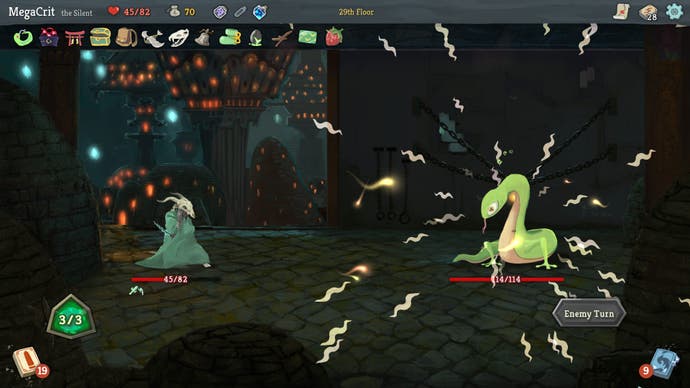
Most of the time, though, you're card battling, and it's truly wonderful stuff. You'll drop into a new floor and be faced with a pack of oddball monsters, all itching to kill you. While they cycle their attacks, you work through various hands of the cards you've collected in your deck, combining offensive strikes with defensive armour-boosting block moves as you make the most of the tight mana limit. The more monster rooms you defeat, the higher up the spire you go, each victory giving you loot like gold and a new card for your arsenal. There are potions for you to rely on when you need a sudden boost of something good and relics that offer perks that last for the entirety of your run, but your life ultimately depends on balancing your health, which does not automatically top itself up between floors, with the richness of your deck, since the higher you go, the more you're going to need a range of cards.
Battling is brilliant. Slay the Spire shows you exactly which attacks your enemies are planning and how much damage they're going to do, which is an idea that has completely grown on me. When you know that you're going to be whacked for 15 HP next turn unless you do something about it pronto, there's a lovely charge to proceedings. Even better, over time I've come to realise that through all this radical transparency the game is actually encouraging you to wrest back the tempo - to find a way to undermine your enemy's plans while still getting in your own attack. Not easy when the mana count is so thrillingly stingy as standard (although it can be boosted with the right plays.)
The cards themselves may lack the glittering charisma of Hearthstone's cards - charisma, is, after all, the stat Blizzard has put so many of its points into - but they're designed to clip together in dizzyingly clever ways. There is a Katamari-like sense of escalation to the right combo. Actually, it's more like vertigo: you find yourself on the brink, staring into the swirling depths of possibilities. One card lays on poison while another does extra damage to poisoned enemies. One card gives you armour while boosting your mana pool, and then the next is a devastating attack that you couldn't afford with your original mana count. These are the most basic of examples, because hours in I'm still learning to move over the surface layer of the game's synergies. I'm also enormously thick. Occasionally a hand will come along that even I can't mess up, however, and damage stacks upon damage in a shamefully satisfying manner.
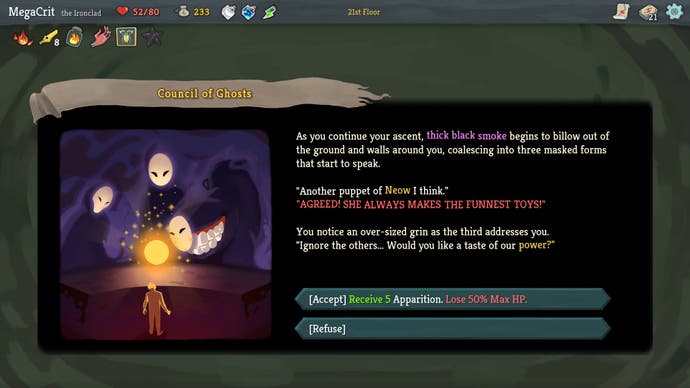
(Even when things go wrong it's something to marvel at. Often enemies choose not to deal direct damage but will instead slide fistfuls of junk cards into your hand. This is a game where you have to be thinking of the unseen deck every bit as much as you're thinking of the cards you have in front of you at present.)
In between battles, things get increasingly strategic. Cards can be upgraded, but not if you need those campfires to regain your health. Gold can be spent on new cards, or on better relics. Everything is a choice, and I love the way that the richness of information you're handed in the battles themselves is countered by the fact that, at the start of a battle you have no idea who or what you're going to be facing.
There are different modes on offer, including a daily challenge (always money in the bank) and a custom mode that allows you to tweak dozens of variables, and then there are a handful of different classes, with their own core cards and mechanics. I gravitate towards stealth characters in most games, but with Slay the Spire I've fallen in love with the wonky robot who goes into battle with three hovering orbs that can be tricked out to do additional damage. It's like Tesla designed a pet class. (Not really, but you know.)
It's all been been sharpened and focused though Early Access, and there's something lovely about paying for a card-battler up-front, too, and knowing that all the game's trinkets are inside the box waiting to be unlocked through play and play alone. The higher you go up the spire, the deeper the pleasures that await, but even if you're a casual like me, this is gorgeous stuff, beautiful, precise and filled with dark delights.
